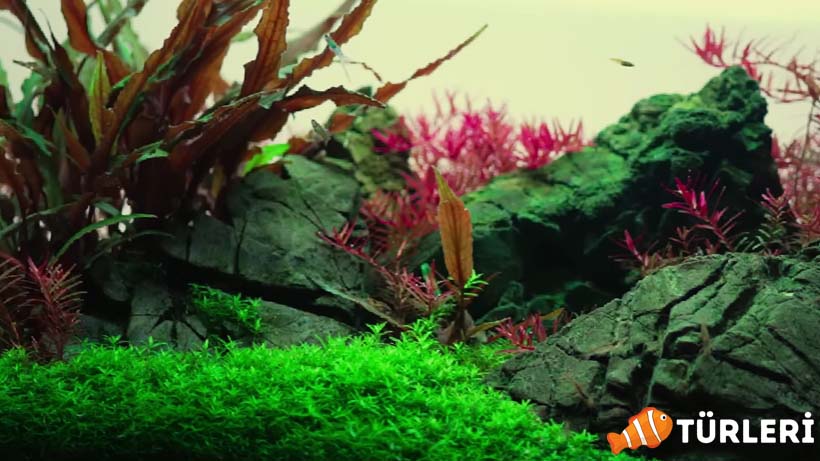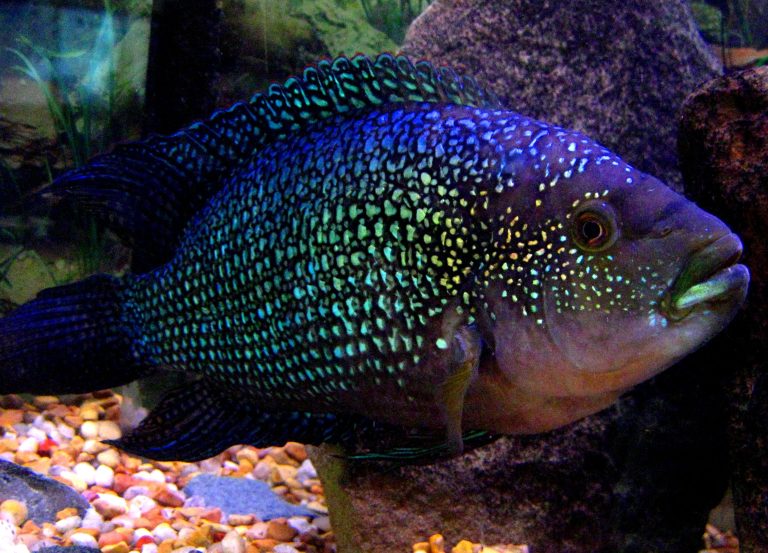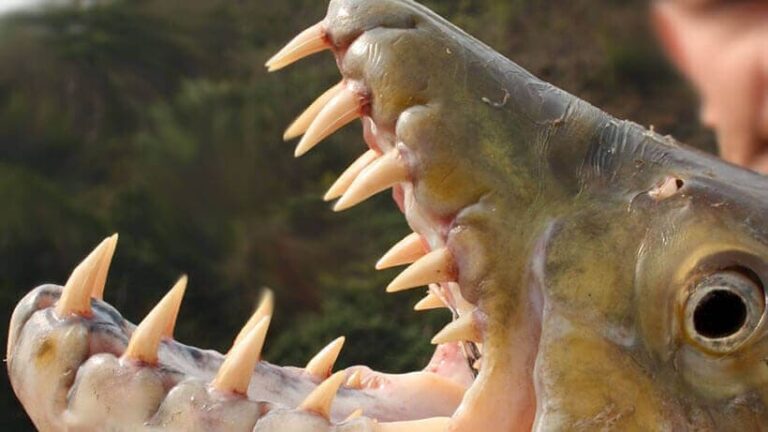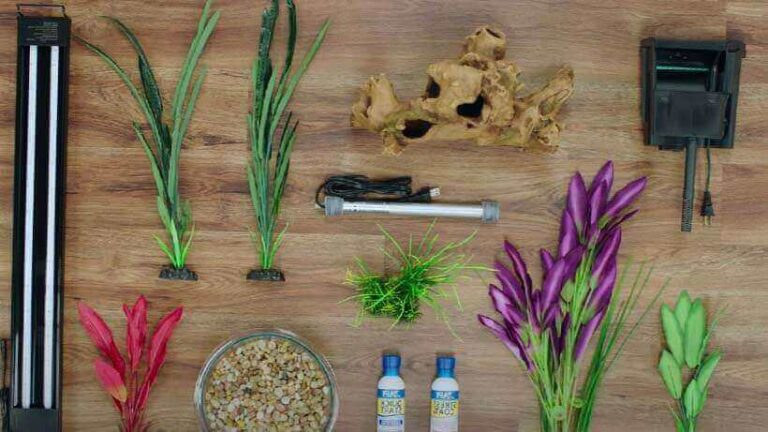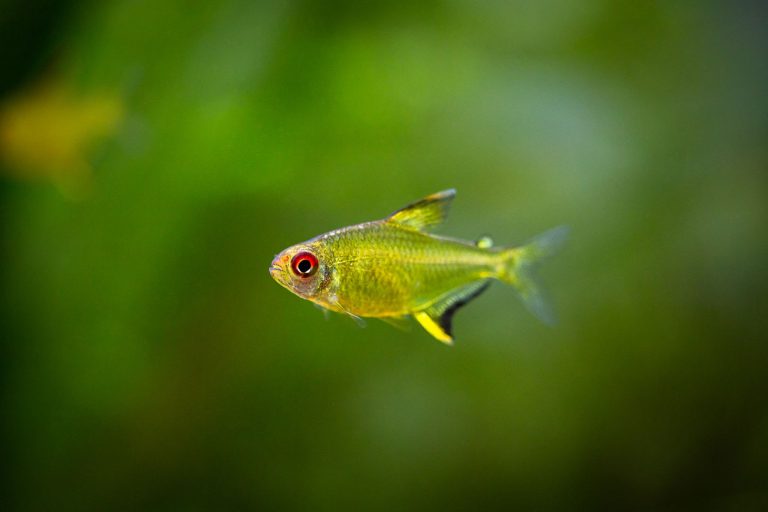Comprehensive Guide to Setting Up a Guppy Aquarium
If you’re looking to set up a guppy aquarium and don’t know where to start, this article will provide you with all the information you need. Thanks to its popularity, the guppy fish is among the top three choices for those new to the hobby.
Below, we’ve listed all the necessary information to set up a guppy aquarium from scratch. Moreover, guppies require minimal care and are among the easiest and most suitable fish species for beginners.
How Should a Guppy Aquarium Be Set Up?
The first question that needs to be asked is: How should a guppy aquarium be? Firstly, small aquariums of 5-15 liters or fishbowls are definitely not suitable for guppies. In fact, excluding creatures like shrimp, no fish can be kept in such small aquariums.
Aquarium Size
Although guppies are small fish, they need a certain space to swim freely. When calculating the volume of the aquarium, you can estimate an average of 4 liters per guppy.
However, this doesn’t mean you can keep them in a 5-10 liter bowl! Guppies are best kept in groups. For guppies, which can grow up to a maximum of 6cm, you should have at least a 45-liter aquarium (for 5 fish).
While the shape of the aquarium isn’t critical, you might prefer a cube-shaped one. An important note on aquariums: if you’re acquiring a second-hand aquarium, make sure there’s no decay or wear on the silicone at the joints.
Filtration
Filtration is one of the most important aspects to consider when answering the question, “How should a guppy aquarium be?” Adding a powerful external filter that can provide good filtration will ensure your aquarium remains stable and healthy.
However, using an external filter is not mandatory for small-sized aquariums. For a guppy aquarium around 45-50 liters, a good quality internal filter or waterfall filter can also be used. Additionally, you should pay attention to filter materials and their order of placement.
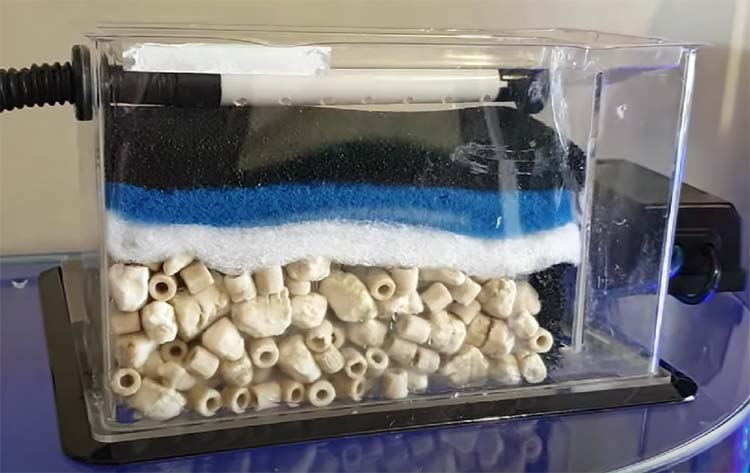
Things to Consider Before Choosing a Filter:
Filter Choice: For up to 60-70 liters, an internal or waterfall filter is suitable, while for larger volumes, an external filter is the best choice. If you don’t use an external filter in larger aquariums, maintaining water quality becomes challenging.
Filtering Speed:
You can calculate this according to the size of the aquarium you are setting up. For instance, if your aquarium is 100 liters, you should choose a filter that can cycle at least 4 times per hour. So, 100×4= 400lt/h filter would be sufficient.
Filter Materials:
It’s suitable to use at least three types of materials. Suppose you have a three-layer filter, and the water flow direction is from top to bottom. In that case, your arrangement should be:
- Coarse pore sponge
- Finer pore sponge
- Biological filter material (e.g., Sera siporax, Seachem matrix, or lava fragments for a cheaper solution)
There are four common filter systems you can use:
- Internal Filter: Suitable for small aquariums. It’s not suitable for medium and large aquariums as they get dirty quickly and won’t suffice. Even if you find 1000 lt/h internal filters in the market, they won’t provide the efficiency of a similar lt/h external filter or sump. If you are setting up a guppy aquarium with a capacity of 60-70 liters, you can use an internal filter.
- External Filter: Depending on the type you buy, it can be used in small, medium, and large aquariums. It’s the most suitable option for setting up a guppy aquarium in terms of ease of use and efficiency. If your budget allows, we recommend using an external filter even for your small aquariums. Using an external filter allows for longer cleaning intervals and better and faster establishment of biological balance.
- Waterfall Filter: Also known as hanging filters, they offer performance comparable to internal filters. Most waterfall filters on the market have a small reservoir, which can quickly become dirty, resulting in reduced performance and insufficient biological filtration.
- Sump: Generally used for very large aquariums. A sump can be separate from the aquarium or built into the back, top, or side. A well-designed sump is very efficient in filtering. However, our recommendation would be to use a sump for aquariums of 300 liters or more.
Heater:
Guppies need a tropical environment to grow, stay healthy, and breed. This means that a heater is not an option, but a necessity. Heaters are the solution to maintaining your aquarium between 22-28 degrees Celsius during winter months when room temperatures drop.
Guppies prefer a steady, stable water temperature. With a heater, you can maintain a consistent temperature. To determine the size of the heater, the rule of 1 watt of energy per 1 liter can be used. This means a 100-watt heater is sufficient for a 100-liter guppy aquarium.
Another important consideration when buying a heater is its quality. Low-quality products can cause all your fish to die. Choosing reputable brands is crucial.
Lastly, if the temperatures in your area rarely drop below 18-20 degrees Celsius, you might not need a heater.
Base – How Should the Guppy Aquarium Gravel Be?
The range of gravel for a guppy aquarium is vast. Whether gravel or sand doesn’t matter much to them. What you should be wary of is using painted, non-natural base materials. You can spread the material of your choice to a height of 3-4 cm on the aquarium floor.
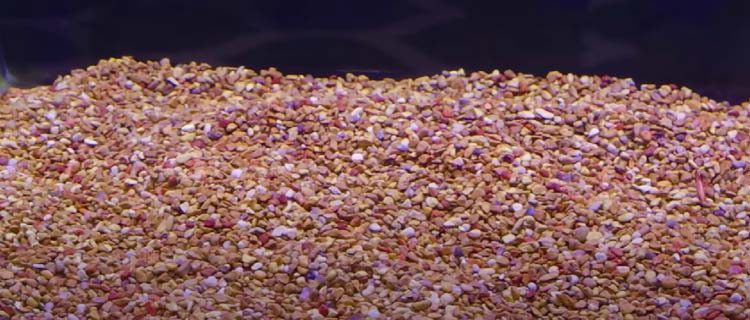
Calculating How Much Sand You Need for a Guppy Aquarium:
You can use the following formula:
Length x Width x Desired sand height / 1000 = Amount of Sand (liters)
Example calculation: 40cm x 40cm x 4cm = 6400 / 1000 = 6.4 lt. Thus, for an aquarium sized 40×40 cm, you need 6.4 liters of material to achieve a 4cm sand height. This calculation will require less volume if used with larger materials like gravel.
For guppies, you can choose to not use any base materials and set up a bare-bottom aquarium.
For a planted guppy aquarium, the above ratios and materials are limited to a few options.
Lighting
If the environment where the aquarium is located receives enough light, additional lighting isn’t mandatory. One of the common mistakes made in our country is exposing the aquariums to direct sunlight. This is a highly misguided approach.
Aquariums exposed to sunlight will start to develop algae on the glass and decorations. Over time, this algae may proliferate to a point where cleaning becomes impractical. Additionally, it can cause odor issues.
If you aren’t planning to add live plants but still want lighting, you should avoid excessive lighting. For strip LEDs and fluorescents, 0.3 watts of lighting per liter will suffice.
If you wish to set up a planted guppy aquarium, lighting is essential. Plants need an adequate amount of light for photosynthesis. Without it, you can’t grow your plants healthily.
Live Plants And Decorations
Guppies live in green, densely planted environments in their natural habitats. This is because they use plants as cover when they need to hide from predators. In a planted aquarium, they feel more at ease. Additionally, fry have a higher chance of survival in an aquarium with live plants.

Before Setting Up a Planted Guppy Aquarium, Check This List:
- First, decide whether you want to go with a low tech (low maintenance) or high tech (high maintenance) setup. (If you have no experience with planted aquariums, we strongly recommend starting with low tech).
- Plan your plants and decorations before setting up.
- Carefully choose foreground, midground, and background plants.
- Determine where you will place each material and plant by sketching it out on paper.
- Correctly determine the needs of the plants you choose (Lighting, fertilizer, substrate, etc.).
- If you’ve planned and checked all the above, starting the planted aquarium setup puts you a step ahead. Although a planted aquarium might seem easy, the first three months can be challenging.
To navigate these challenging days best and own a beautiful live planted aquarium, you must research thoroughly.
If you don’t want plants, avoid materials like rocks and decorations that will harden the water. Try to use natural materials as much as possible. Lava rock, both in shape and appearance, is a suitable decoration for guppies.
Plants for Guppy Aquariums
Choosing plants for guppies is not difficult, and all plant varieties are compatible. When choosing plants, consider the volume of the aquarium.
For aquariums up to 100 liters, it’s wise to choose easy-care plants like olive, rose, and foxtail. To best raise the fry, various mosses can be added. The microorganisms that form in mosses contribute to the nutrition of guppy fry.
Other Materials
We have listed the necessary materials for guppy aquarium care. Knowing what you need before and during setup will prevent mistakes.
- Air pump: Helps maintain oxygen balance and enriches the water with oxygen. The bubbles that rise and burst at the surface help balance oxygen levels. Not necessary if there’s an internal filter.
- Fish net: A tool for removing foreign substances, transferring fish, etc. To prevent introducing diseases into the aquarium, avoid putting your hand directly into the water. A fish net helps you achieve this.
- Gravel vacuum (Siphon): Helps clean residues like leftover food and waste from the aquarium floor. Essential for basic maintenance and removing harmful waste. Ignoring this can disrupt several water parameters.
- Bucket: Necessary for removing old water and disposing of waste during weekly water changes.
- Chlorine remover: Used to de-chlorinate water during water changes. Not necessary if using de-chlorinated water or if you can let tap water sit uncovered for two days. Tap water in our country is not directly suitable for aquariums.
- Breeding box: Guppies are more prolific than many other fish species. If you’re setting up a planted guppy aquarium, you may choose to let the fry grow naturally. If there’s not enough hiding places in the aquarium, adults might consume the fry.
- Guppy food: Don’t skimp on food quality. Fish food directly affects water parameters and fish health. Always use quality food suitable for guppies. Quality food also enhances the fish’s color.
- Test kit: If you set everything up correctly from the start and don’t neglect maintenance, you don’t need a test kit. But if you’re new to planted aquariums, you should get a basic test kit. Essential for monitoring vital parameters like pH, nitrite, and ammonia.
Moscow Blue Guppy Features Creating the Nitrogen Cycle
If you’ve researched how a guppy aquarium should be, you’ve probably come across terms like “nitrogen cycle” and “new aquarium syndrome.” While the subject seems complex, it’s not hard to address.
What is the Nitrogen Cycle in Aquariums?
In simple terms, healthy aquariums, when everything is done correctly, contain beneficial bacteria (Nitrosomonas and Nitrobacter). These bacteria break down ammonia from waste into nitrite and then into nitrate, facilitating the nitrogen cycle.
Establishing a nitrogen cycle in aquariums is vital for fish health. In aquariums where this cycle hasn’t been established, fish can quickly die or suffer from diseases.
In their natural habitats, fish don’t suffer from poisoning due to accumulated waste. This is because their environment, unlike aquariums, has its established ecosystem, and they don’t live densely packed in a confined space.

How to Cultivate Beneficial Bacteria in the Aquarium?
Beneficial bacteria play a vital role in maintaining a balanced aquatic environment. It usually takes about 2 months to establish a good bacteria colony in a new aquarium. However, with specific methods, this can be reduced to approximately 2 weeks.
- Inoculation from Established Aquariums: You can introduce water, gravel, or filter material from a well-established and healthy aquarium to boost bacteria in your tank.
- Commercial Bacterial Cultures: There are commercial products available in the market that contain beneficial bacteria, which can be introduced into the aquarium.
- Let Nature Take Its Course: This is the slowest method. You wait for the bacteria to naturally colonize the aquarium, but this could be challenging and risky for the fish.
Adding Guppies (Lepistes) to the Aquarium
Once your aquarium is set up and the nitrogen cycle is established, you can introduce your guppies. Depending on which method you choose for bacterial colonization, this could be anywhere between 2 weeks and 2 months.
Guppy Fry Release into the Aquarium
Guppy fry will begin to show their colors between 45-60 days, after which their gender becomes distinguishable. At around 2 months, they can be considered as juveniles and can be safely added to the main tank.
How Many Guppies Should I Add?
The following is a guideline for the number of guppies you can introduce based on the aquarium size:
| 40 Liters | 6 Guppies |
| 60 Liters | 10 Guppies |
| 80 Liters | 14 Guppies |
| 100 Liters | 18 Guppies |
| 120 Liters | 22 Guppies |
| 150 Liters | 30 Guppies |
When introducing the guppies into your tank, consider the following:
- Water Temperature: Float the bag with the guppies in your aquarium for about 20-30 minutes to equalize the temperature.
- Avoid Shock: Don’t just pour the guppies into the tank as it can cause stress and make them prone to illnesses.
- Acclimatization: Transfer guppies to a container and slowly add your aquarium water over 15-20 minutes to acclimate them to your water parameters.
- Use a Fish Net: Only transfer the guppies without adding the water from the bag to your aquarium.
For more detailed information on guppy care, distinguishing genders, feeding, and breeding, refer to the article “Guppy Fish Care and Gender Differentiation 2022.”
How Many Liters Should a Guppy Aquarium Be?
The required volume of the aquarium varies depending on the number of guppies you intend to keep. For 5 guppies, you should have at least a 45-liter aquarium. An easy calculation method to determine the suitable aquarium size is available: Adult fish length (in cm) x 1.5 x number of fish = required aquarium volume in liters
Can Guppies Live Alone?
Guppies should be kept in groups of at least five or more. Therefore, if you wish to keep them, you should obtain them in groups of five or its multiples.

